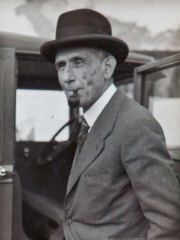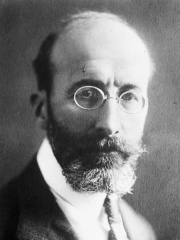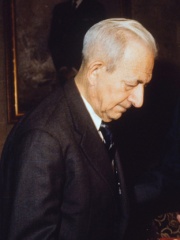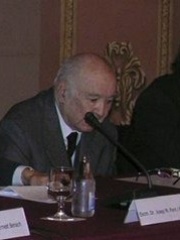




The Most Famous
LINGUISTS from Spain
This page contains a list of the greatest Spanish Linguists. The pantheon dataset contains 214 Linguists, 6 of which were born in Spain. This makes Spain the birth place of the 9th most number of Linguists behind Switzerland, and Ukraine.
Top 6
The following people are considered by Pantheon to be the most legendary Spanish Linguists of all time. This list of famous Spanish Linguists is sorted by HPI (Historical Popularity Index), a metric that aggregates information on a biography’s online popularity.

1. Pompeu Fabra (1868 - 1948)
With an HPI of 61.61, Pompeu Fabra is the most famous Spanish Linguist. His biography has been translated into 51 different languages on wikipedia.
Pompeu Fabra i Poch (Catalan pronunciation: [pumˈpɛw ˈfaβɾə]; Gràcia, Barcelona, 20 February 1868 – Prada de Conflent, 25 December 1948) was a Catalan engineer and grammarian from Spain. He was the main author of the normative reform of contemporary Catalan language.

2. Ramón Menéndez Pidal (1869 - 1968)
With an HPI of 54.16, Ramón Menéndez Pidal is the 2nd most famous Spanish Linguist. His biography has been translated into 28 different languages.
Ramón Menéndez Pidal (Spanish pronunciation: [raˈmom meˈnendeθ piˈðal]; 13 March 1869 – 14 November 1968) was a Spanish philologist and historian. He worked extensively on the history of the Spanish language and Spanish folklore and folk poetry. One of his main topics was the history and legend of El Cid. He was nominated for the Nobel Prize in 26 separate years, the most nominations of any other person.

3. Joan Coromines (1905 - 1997)
With an HPI of 52.00, Joan Coromines is the 3rd most famous Spanish Linguist. His biography has been translated into 21 different languages.
Joan Coromines i Vigneaux (Catalan pronunciation: [ʒuˈaŋ kuɾuˈminəs]; also frequently spelled Joan Corominas; Barcelona, Catalonia, Spain 1905 – Pineda de Mar, Catalonia, Spain, 1997) was a linguist who made important contributions to the study of Catalan, Spanish, and other Romance languages. His main works are the Diccionario crítico etimológico de la lengua castellana (1954–1957), in four volumes, first version of his etymological dictionary of Spanish (with an abridged version, Breve diccionario etimológico de la lengua castellana, first published in 1961); the Diccionari etimològic i complementari de la llengua catalana, which investigates the origin of most words in the Catalan language (9 volumes); the Onomasticon Cataloniae, documenting place and person names, old and new, in all the Catalan-speaking territories (8 volumes); and, with José Antonio Pascual, the Diccionario crítico etimológico castellano e hispánico, the most thorough etymological dictionary of Spanish extant today. Following this research, he—along with Koldo Mitxelena—made key contributions to the study of the Basque language's geographical extent across the Pyrenees during the early Middle Ages. Coromines studied at the University of Barcelona, and started working on linguistics from an early age. At the same time, he held strongly Catalanist convictions all his life. He was forced into exile after the Spanish Civil War, eventually holding a professorship at the University of Chicago, in 1948. He returned to Catalonia later, and spent his last years working on his main works: the etymological dictionaries and the Onomasticon. He refused several prizes from the Spanish government, in protest at the treatment of the Catalan language and culture in Spain. In honor of Coromines, in April 2006 the University of Chicago inaugurated the Càtedra Joan Coromines d'Estudis Catalans, a teaching chair for visiting professors of Catalan language and literature.

4. Germà Colón (1928 - 2020)
With an HPI of 48.60, Germà Colón is the 4th most famous Spanish Linguist. His biography has been translated into 17 different languages.
Germà Colón i Doménech (30 November 1928 – 22 March 2020) was a Spanish philologist of Romance philology and Catalan lexicology. He was appointed a professor at the University of Basel, in Switzerland.

5. Martí de Riquer i Morera (1914 - 2013)
With an HPI of 47.63, Martí de Riquer i Morera is the 5th most famous Spanish Linguist. His biography has been translated into 15 different languages.
Martí de Riquer i Morera, 8th Count of Casa Dávalos (Catalan pronunciation: [məɾˈti ðə riˈkej muˈɾeɾə], Spanish: Martín de Riquer y Morera) (3 May 1914 – 17 September 2013) was a Spanish literary historian and Romance philologist, a recognised international authority in the field. His writing career lasted from 1934 to 2004. He was also a nobleman and Grandee of Spain.

6. Francisco Rodríguez Adrados (1922 - 2020)
With an HPI of 45.51, Francisco Rodríguez Adrados is the 6th most famous Spanish Linguist. His biography has been translated into 15 different languages.
Francisco Rodríguez Adrados (29 March 1922 – 21 July 2020) was a Spanish Hellenist, linguist and translator. He worked most of his career at the Complutense University of Madrid. He was a member of the Real Academia Española and Real Academia de la Historia.
People
Pantheon has 6 people classified as Spanish linguists born between 1868 and 1928. Of these 6, none of them are still alive today. The most famous deceased Spanish linguists include Pompeu Fabra, Ramón Menéndez Pidal, and Joan Coromines.
Deceased Spanish Linguists
Go to all RankingsPompeu Fabra
1868 - 1948
HPI: 61.61
Ramón Menéndez Pidal
1869 - 1968
HPI: 54.16
Joan Coromines
1905 - 1997
HPI: 52.00
Germà Colón
1928 - 2020
HPI: 48.60
Martí de Riquer i Morera
1914 - 2013
HPI: 47.63
Francisco Rodríguez Adrados
1922 - 2020
HPI: 45.51
Overlapping Lives
Which Linguists were alive at the same time? This visualization shows the lifespans of the 6 most globally memorable Linguists since 1700.

